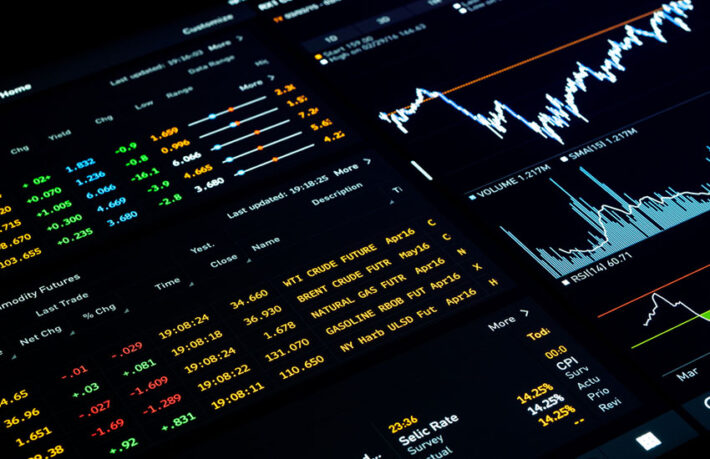The Key Trading Indicators Every Investor Should Master
Knowing how to use tools such as indicators is fundamental for trading in the financial markets. They provide the ability to understand price movements in assets, helping traders discover better buying or selling opportunities. In this article, we will explore the most commonly used indicators in trading.
Indicators make it easier to interpret the behavior of financial asset prices, as they visually represent trends and volume. This visualization helps traders identify the best moments to enter or exit trades.
With that in mind, we invite you to continue reading to learn more about trading indicators, their types, and the most widely used ones in the financial markets.
What Are Indicators in Trading?
An indicator in trading is a mathematical calculation based on an asset’s price position or trading volume. It reveals patterns and trends that help analyze an asset’s behavior.
In trading, there is always a debate between the two primary methods of market analysis: technical analysis and fundamental analysis. Some traders believe one is superior to the other, while others see them as complementary tools that vary depending on individual trading styles and strategies.
- Fundamental analysis focuses on financial data, such as a company’s earnings reports and economic factors influencing asset value.
- Technical analysis focuses on price movements, using tools like charts, bars, and indicators to identify patterns and trading opportunities.
If your trading strategy is based on technical analysis, understanding indicators will be highly beneficial.
Every trader has a preferred indicator. For example, Warren Buffett—one of the most renowned investors—uses The Buffett Indicator, which is calculated by dividing the total valuation of the U.S. stock market by GDP. This is a widely discussed term in investing, making it essential to become familiar with it.
It’s important to remember that indicators serve as confirmation tools. While they help identify potential trends, the ability to analyze data properly and form an objective opinion will ultimately determine when to enter or exit a trade.
Types of Indicators in Trading
Trend-Following Indicators
Trend-following indicators analyze the direction and strength of trends over a selected period.
Some of the most commonly used trend indicators include:
- SMA (Simple Moving Average)
- EMA (Exponential Moving Average)
- ADX (Average Directional Index)
- MACD (Moving Average Convergence/Divergence)
- RSI (Relative Strength Index)
Volume Indicators
Volume indicators measure the amount of trading activity in a specific financial asset. High volume often indicates increased market interest, driven by news or events.
Examples of popular volume indicators:
- A/D (Accumulation-Distribution)
- CMF (Chaikin Money Flow)
- VO (Volume Oscillator)
- BOP (Balance of Power)
- OBV (On Balance Volume)
Volatility Indicators
Volatility indicators measure how much an asset’s price fluctuates. Understanding volatility helps traders assess risk before entering a trade. High volatility often means higher risk and potential reward.
Some widely used volatility indicators include:
- Bollinger Bands
- Keltner Channel
- Donchian Channel
- ATR (Average True Range)
Momentum Indicators
Momentum indicators help traders assess the strength of an asset’s price movement. They indicate whether an asset is overbought or oversold, helping to anticipate potential reversals.
Some of the most commonly used momentum indicators:
- MACD (Moving Average Convergence/Divergence)
- Stochastic Oscillator
- RSI (Relative Strength Index)
- ADX (Average Directional Index)
- CCI (Commodity Channel Index)
How to Use Trading Indicators?
Trading indicators help predict probable price behavior, assisting traders in deciding whether to buy, hold, or sell an asset.
Understanding trends allows traders to identify asset price directions and uncover potential market opportunities. The effectiveness of indicators depends on the strategy used and the timeframes analyzed.
For example, if you are a day trader, volume indicators should be a crucial part of your strategy since volatility is essential for opening and closing trades within the same day.
Although indicators are valuable tools, they do not guarantee certainty in the market. A trader’s analytical skills and emotional discipline will play a crucial role in making successful trading decisions.
Most Used Indicators in Trading
While the choice of indicators depends on individual trading strategies, here are seven of the most commonly used indicators that traders should master:
- Keltner Channel Indicator – Creates two bands above and below the asset’s price, helping detect potential trends.
- Regression Lines – Used to identify trends by plotting lines over consecutive days, helping determine entry and exit points.
- MACD (Moving Average Convergence Divergence) – A trend and momentum indicator that tracks the relationship between two moving averages.
- ADX (Average Directional Index) – Measures the intensity of a trend to minimize risk and maximize profitability.
- RSI (Relative Strength Index) – Analyzes price strength to anticipate possible trend reversals.
- Stochastic Oscillator – Evaluates a stock’s price in relation to its historical highs and lows over a given period.
- Bollinger Bands – Measures market volatility by plotting deviation levels above and below a moving average.
Conclusion
Trading indicators are essential tools for understanding asset behavior in financial markets. They help improve investment strategies and enhance decision-making for better returns.
By combining indicators with solid technical analysis and proper emotional management (psychotrading), traders can make well-informed decisions while reducing risks.
There is no perfect indicator that works in all situations, but selecting the right ones based on your trading style and objectives will be crucial for achieving success in the financial markets.


